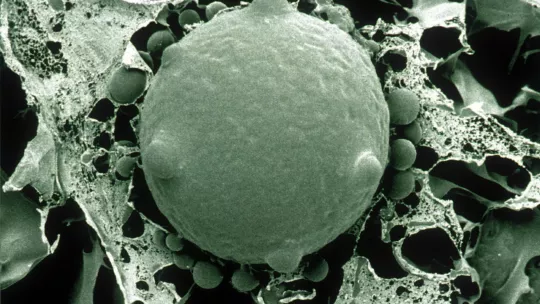Images
The system that regulates cellular calcium levels duplicated, generating two non-equivalent systems, some one billion years ago before fungi and animals diverged evolutionarily.
The fungal models currently used for the study of mitochondrial calcium regulation are not adequate, as the system they possess is not equivalent to that of animals. Chytrids, a divergent group of fungi, would be the only fungi that possess a system similar to ours.
The study by IRB Barcelona's Comparative Genomics Laboratory has been published in the journal Nature Communications.
Calcium levels regulate multiple processes in cells, ranging from metabolism to division. And these levels are regulated, in turn, by calcium transport into and out of mitochondria, the energy hub of the cell. The regulation of calcium levels is, therefore, a recurring topic of study, with important implications in biomedicine. In this context, fungi are often the model organisms of choice to study this system.
The Comparative Genomics Laboratory of the Institute for Research in Biomedicine (IRB Barcelona), headed by ICREA researcher Toni Gabaldón, and the Barcelona Supercomputing Center (BSC-CNS) has revealed that the transporter that regulates cellular calcium levels duplicated around one billion years ago, giving rise to two transporter subtypes. Of these, only one is present in animals, while most fungi conserve the other. Chytrids—aquatic microscopic organisms—are the only family in the fungal kingdom that has the same transporter subtype as animals. Therefore, the use of the calcium transporter of any other kind of fungus as a model could lead to incoherent observations and incorrect conclusions.
“Determining how cell systems came about and evolved helps us to understand them and to choose appropriate model organisms for research purposes,” says Gabaldón.
An extensive computational analysis of more than 1000 organisms
Published in the journal Nature Communications, this study used computational methods to analyse the complete genome of more than 1000 organisms, in order to reconstruct the evolution of the calcium transport machinery in mitochondria. The analysis corroborated the ancestral origin of this mitochondrial transport system, which was already present in the common ancestor of fungi and animals.
Fabiana Perochi's laboratory at the Helmholtz Zentrum in Munich (Germany) carried out experimental tests that confirmed that chytrid proteins perform a function equivalent to that of humans.
The paradox of fungi that do not transport calcium
It had previously been observed that the calcium transporter in fungi acts differently from that in animals and it’s even present in organisms that do not transport calcium to mitochondria. This observation was considered a paradox.
"By reconstructing the evolutionary history of these proteins, we have been able to resolve a paradox and identify the true equivalents of the human system in fungi. This finding opens up new avenues for their use as experimental models," concludes Gabaldón.
Related article:
Alexandros A. Pittis, Valerie Goh, Alberto Cebrian-Serrano, Jennifer Wettmarshausen, Fabiana Perocchi & Toni Gabaldón
Discovery of EMRE in fungi resolves the true evolutionary history of the mitochondrial calcium uniporter
Nature Communications (2020) DOI: 10.1038/s41467-020-17705-4
About IRB Barcelona
The Institute for Research in Biomedicine (IRB Barcelona) pursues a society free of disease. To this end, it conducts multidisciplinary research of excellence to cure cancer and other diseases linked to ageing. It establishes technology transfer agreements with the pharmaceutical industry and major hospitals to bring research results closer to society, and organises a range of science outreach activities to engage the public in an open dialogue. IRB Barcelona is an international centre that hosts 400 researchers and more than 30 nationalities. Recognised as a Severo Ochoa Centre of Excellence since 2011, IRB Barcelona is a CERCA centre and member of the Barcelona Institute of Science and Technology (BIST).







